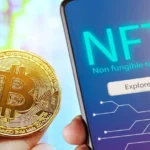A phenomenon named NFT (non-fungible token) has been rapidly gaining popularity in the digital world. NFTs are closely linked to cryptocurrencies since they’re stored on a blockchain. They came into use with the emergence of the Ethereum cryptocurrency, which was the first digital asset to allow the creation and exchange of non-interchangeable tokens. There are now many other blockchains that support NFTs but Ethereum remains the most popular choice.
NFTs are basically unique units of data that can’t be exchanged for anything else. Practically anything digital can be an NFT, but they are most commonly associated with pieces of digital art such as pictures, GIFs, videos, and music. Artists can sell their pieces in NFT marketplaces and transfer the ownership of the work to the buyer whilst retaining their copyrights and the piece possibly being publicly available on the Internet.
Despite their wide popularity, NFTs are still very controversial, partly because of them being perceived as a questionable investment and partly due to their negative impact on the environment. The latter is the issue I will analyze in this article. Let’s see why most NFTs (particularly the ones on the Ethereum blockchain) are not eco-friendly, analyze the ways to overcome this problem and look further into how effectively they work.
What Do NFTs Do to the Environment?
At first glance, it’s hard to understand how a small digital art project can have a negative impact on our planet. But it does and it has to do with its blockchain-based nature. Many cryptocurrencies, especially those with the proof-of-work consensus, are responsible for tons of carbon dioxide emissions that are slowly destroying the Earth. Since NFTs are inseparable from crypto and are bought and sold with digital currency such as Ethereum (which is very energy hungry), they must take at least part of the blame.
Of course, one can argue that the same amount of crypto would probably still be mined without NFTs, which is a valid point. On the other hand, since NFTs are in such wide circulation, they might encourage blockchains to issue more crypto and consequently cause even more damage to the environment.
So, is there a solution that can keep NFTs running but not kill our planet at the same time?
Alternative and Eco-Friendly Ways to Run NFTs
Since the issue of NFTs playing a role in speeding up climate change has been discussed lately, many solutions to the problem have been proposed. Predictably, the most popular idea is to create “green” cryptocurrencies that could support NFTs. Blockchains based on the proof-of-stake network or using additional layers in their proof-of-work system are much more sustainable than, say, Ethereum. ETH itself has been said to switch to the proof-of-stake model eventually but no one knows when that’s actually going to happen. This is why it might be more effective to use new private eco-friendly digital assets for NFT support. Many have already been created. So let’s look at some of the examples.
“Green” NFT Projects
Tezos
Tezos is currently one of the most popular projects that promise a relatively environmentally-friendly use of NFTs. Founded in 2018, this blockchain uses a proof-of-stake self-upgradable model that allows its community to change an asset according to their needs. Tezos claims to have an annual carbon footprint equivalent to that of only 17 global citizens. Customers use this blockchain in different ways, from creating decentralized apps and art to playing games and sharing collections. One noteworthy example is an NFT mixtape called Ziggurats.
Last year, Tezos raised $63M to launch NFT music collectibles that will feature current and late popular artists. Some of the musicians supporting the idea include Doja Cat, the Weekend, Mick Jagger, Mike Shinoda, and others. Tezos also expanded its popularity by partnering with other well-known NFT projects such as OpenSea, InterPop, Emergents, etc.
Polygon
Polygon is a blockchain network that uses a proof-of-stake model. The project was first launched in 2017 with the Polygon token coming into use in 2019. MATIC quickly became a widely popular cryptocurrency and skyrocketed in value during the last couple of years.
Polygon claims to be eco-conscious and has a relatively low amount of CO2 emissions (0.0003 kg per transaction), especially compared to other blockchains such as ETH. This is why NFTs supported by the network are considered “green”. Last year, Polygon partnered with Cent and announced that it had built infrastructure to develop sustainable and reasonably priced NFTs.
KodaDot
KodaDot is a lesser-known community-driven NFT platform. Based on Kusama and Polkadot networks, it claims to provide NFT experience with a low carbon footprint. The platform also supports NFT collections and galleries.
There are many other eco-conscious NFT projects mainly based on the proof-of-stake model blockchains. More and more energy-efficient solutions appear every day.
The Bottom Line
Importantly, people understand the urgency of the climate crisis and work on solutions to make their work eco-friendly. “Green” NFT projects exist and seem to work but the fact that they emit fewer greenhouse gases than the first NFT blockchains does not mean they’re completely safe for the planet. So, is it possible to create digital assets and art projects that will have no negative impact at all? That remains to be seen. Let’s try to share the optimistic crypto artists’ point of view and hope that there is a way for the digital economy to exist without destroying our planet.










